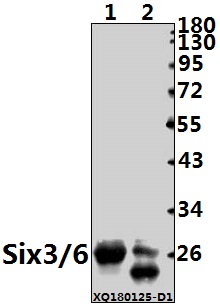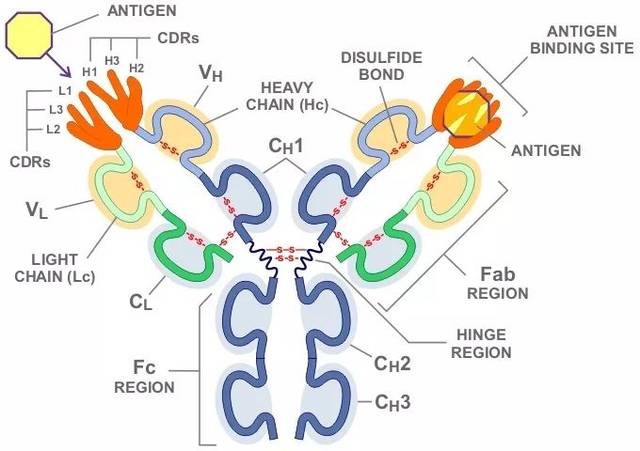Product Name :
Six3/6 (D228) polyclonal antibody Background :
The SIX proteins (sine oculis) are a family of homeodomain transcription factors that share a conserved DNA binding domain. Two of these family members Six3 and Six6 (also designated Optx2 and Six9) are required for the specification and proliferation of the eye field in vertebrates, and, therefore, are the vertebrate homologues most closely related to the Drosophila sine oculis protein, which has an essential role in controlling compound eye development. Six3 and Six6 expression largely overlap during development of specific tissues, such as retina, hypothalamus, and pituitary. Deletion of Six3 may be associated with HPE2 disorder, a common, severe malformation of the brain that results from incomplete cleavage of the forebrain during early embryogenesis. Product :
Rabbit IgG, 1mg/ml in PBS with 0.02% sodium azide, 50% glycerol, pH7.2 Storage&Stability :
Store at 4°C short term. Aliquot and store at -20°C long term. Avoid freeze-thaw cycles. Specificity :
Six3/6 (D228) polyclonal antibody detects endogenous levels of Six3 protein (35 KDa), and also detects Six6 protein (28 KDa). Immunogen :
Synthetic peptide, corresponding to amino acids 201-250 of Human Six3. Conjugate :
Unconjugated Modification :
Unmodification
Six3/6 (D228) polyclonal antibody Background :
The SIX proteins (sine oculis) are a family of homeodomain transcription factors that share a conserved DNA binding domain. Two of these family members Six3 and Six6 (also designated Optx2 and Six9) are required for the specification and proliferation of the eye field in vertebrates, and, therefore, are the vertebrate homologues most closely related to the Drosophila sine oculis protein, which has an essential role in controlling compound eye development. Six3 and Six6 expression largely overlap during development of specific tissues, such as retina, hypothalamus, and pituitary. Deletion of Six3 may be associated with HPE2 disorder, a common, severe malformation of the brain that results from incomplete cleavage of the forebrain during early embryogenesis. Product :
Rabbit IgG, 1mg/ml in PBS with 0.02% sodium azide, 50% glycerol, pH7.2 Storage&Stability :
Store at 4°C short term. Aliquot and store at -20°C long term. Avoid freeze-thaw cycles. Specificity :
Six3/6 (D228) polyclonal antibody detects endogenous levels of Six3 protein (35 KDa), and also detects Six6 protein (28 KDa). Immunogen :
Synthetic peptide, corresponding to amino acids 201-250 of Human Six3. Conjugate :
Unconjugated Modification :
Unmodification
-
 Western blot (WB) analysis of Six3/6 (D228) pAb at 1:500 dilution Lane1:The Eye tissue lysate of Mouse (10ug) Lane2:The Eye tissue lysate of Rat(5ug)
Western blot (WB) analysis of Six3/6 (D228) pAb at 1:500 dilution Lane1:The Eye tissue lysate of Mouse (10ug) Lane2:The Eye tissue lysate of Rat(5ug)
Bioworld Biotech only provide peptides for our antibodies and do not provide additional peptide customization services.
Price/Size :
USD 368/1mg/vial
Tips:
For phospho antibody, we provide phospho peptide(0.5mg) and non-phospho peptide(0.5mg).Describe :
Blocking peptides are peptides that bind specifically to the target antibody and block antibody binding. These peptide usually contains the epitope recognized by the antibody. Antibodies bound to the blocking peptide no longer bind to the epitope on the target protein. This mechanism is useful when non-specific binding is an issue, for example, in Western blotting (WB) and Immunohistochemistry (IHC). By comparing the staining from the blocked antibody versus the antibody alone, one can see which staining is specific; Specific binding will be absent from the western blot or IHC performed with the neutralized antibody.Formula:
Synthetic peptide was lyophilized with 100% acetonitrile and is supplied as a powder. Reconstitute with 0.1 ml DI water for a final concentration of 10 mg/ml.The purity is >90%,tested by HPLC and MS.
Storage:
The freeze-dried powder is more stable. For short time at 2-8°C. For long term storage store at -20°C.
Note :
This product is for research use only (RUO only). Not for use in diagnostic or therapeutic procedures.
 Six3/6 (D228) polyclonal antibody
Six3/6 (D228) polyclonal antibody  Datasheet
Datasheet COA
COA MSDS
MSDS SHIP
SHIP